What Pound Line Is Best For Centerpin Fishing
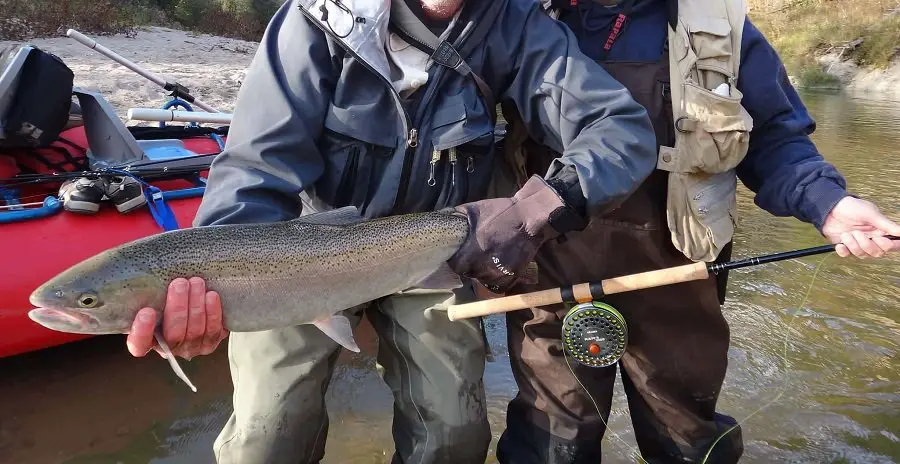
What pound line is best for Centerpin fishing and float fishing for trout, steelhead, and salmon will depend on a few factors. I discuss mainlines and leaders that river guides like me use on Centerpin reels and why certain fishing lines and sizes are better.
The best pound line for Centerpin fishing is the 8lb test for most river conditions around the Great Lakes. The 8-pound line is also the best pound test line for Centerpin fishing in smaller rivers for trout and steelhead, but if you fish bigger rivers or you fish for salmon, you may need to go up to a 14-pound test line.
Key Takeaways
- Not all lines are created equal: Not all lines should be used for centerpin fishing. The best lines for centerpin fishing are monofilament lines that are buoyant. Another good mainline option for centerpin fishing is braided line.
- Not all fishing lines are rated properly: One brand’s 10-pound line might be the thickness of another brands 18-pound line. The mainline diameter matters a lot.
- Thick Lines Suck: Many anglers use lines that are too heavy or too thick for centerpin fishing. Thick lines have some disadvantages, like not casting well, being too stiff, sagging, sinking, and tangling more often. This is why many skilled Centerpin anglers are using very light mainlines.
- Consider Your Weakest Link: Your leader is your weakest link, so it makes no sense to use a 20-pound mainline just because the fish are big and strong if your maximum leader size is 12 pounds. You only need a mainline one or two sizes larger than your normal leader size.
- Consider What You Actually Need: Your mainline and leader size will depend on many factors, which can include the species you might catch and the size and speed of the rivers. See our easy-to-read chart.
Centerpin Mainline Sizing Chart
The mainlines listed in this line sizing chart are the tested and most used lines. They are what I would consider minimum sizes, which is what I recommend.
You also need to ensure you are using the right size leader line. See our leader sizing chart below.
| Region | Fish Species | River Type | Recommended Mainline |
|---|---|---|---|
| Great Lakes Region | Steelhead | Small Rivers | 6 to 8 pound |
| Great Lakes Region | Steelhead | Medium Rivers | 8 pound |
| Great Lakes Region | Steelhead | Large Rivers/Fast Current | 10 to 12 pound |
| Great Lakes Region | Salmon | Small Rivers | 8 pound |
| Great Lakes Region | Salmon | Medium Rivers | 10 pound |
| Great Lakes Region | Salmon | Large Rivers/Fast Current | 12 to 14 pound |
| West Coast Region | Steelhead | Small Rivers | 8 pound |
| West Coast Region | Steelhead | Medium Rivers | 10 pound |
| West Coast Region | Steelhead | Large Rivers/Fast Current | 12 to 14 pound |
| West Coast Region | Salmon | Small Rivers | 10 pound |
| West Coast Region | Salmon | Medium Rivers | 12 pound |
| West Coast Region | Salmon | Large Rivers/Fast Current | 14 to 16 pound |
| – | Trout | Small Rivers | 4 to 6 pound |
| – | Trout | Medium Rivers | 6 to 8 pound |
| – | Trout | Large Rivers/Large Trout | 8 pound |
What Pound Line Is Best For Centerpin Fishing?
Many factors dictate what pound mainline is best for you, but my advice is to always go with the lightest or thinnest mainline possible. Light lines have many advantages when Centerpin fishing.
Before you choose your centerpin line, you will need to consider what species you will be fishing for and the leader size that is required for landing big steelhead, salmon, and trout.
You should also get the right line for the area you will be fishing since, in my opinion, steelhead and salmon on the West Coast tend to fight harder than on the Great Lakes rivers.
Before You Buy A Mainline For Float Fishing
I have had the opportunity as a full-time guide to see just about every mainline in action, and honestly, some lines are really bad for float fishing. So, before you go buy a mainline, there are four things to consider.
Buoyant Lines Are Better: Some lines are more buoyant than others. Lighter, thinner lines tend to be more buoyant. You do not want your mainline sinking and getting pulled around by the current. You want it floating high for two reasons.
A line under the water can get caught in currents that pull the float in directions you do not want, and you can’t lift and mend the line without pulling the float if the line is a foot underwater. You want a high floating line that can easily be lifted up and off the water and repositioned to keep a good drift going.
I have also seen a guy miss fish on the hook set because the line was deep under the water. Setting the hook with a floating line is much better.
Consider lines that are specially made for centerpin reels and float fishing. Or use lines that have been tested and proven to work well.
Line Ratings Are Flawed: Keep this in mind: many mainlines and some leader lines are not rated properly.
Your 8-pound mainline will often be 4 to 8 pounds heavier than a typical 8-pound leader. See below for my comparison.
I have seen fishing line tests done that show lines with a 12-pound label that end up really being 22 pounds when tested. So when your leader has a true breaking strength of 8 or 10 pounds, there is no reason to need a mainline that breaks at 22 pounds. I will discuss this more below. This can happen with leaders too.
Line Sag: Light, thin lines also don’t sag as much as heavier thicker lines. The sag between your rod tip and float is not good. You want to keep the mainline off the water as long as possible, and this is easier done with thinner lighter lines.
Line Color: I am a big advocate of brightly colored lines. So, as long as you set up your leader effectively, bright-colored lines have many benefits.
What Pound Line Is Best For Steelhead Fishing Great Lakes Rivers
Some of my very skilled buddies that fishing around the Great Lakes for steelhead are using a 6-pound mainline, and these guys know what they are doing because they tend to catch more fish than most anglers.
I’m not going to tell you to use such a light line because I use and recommend the 8-pound mainline for most Great Lakes steelhead fishing. I and my clients have landed thousands of steelhead without the 8-pound mainline breaking, so it is proven to be an effective size.
Plus, the 8-pound line is lightweight and thinner, and in my opinion, thinner lines cast better; they tend to be more buoyant, especially if you use the right brand and you want a buoyant line for mending and better drifts.
Most Great Lakes rivers are small to medium size and 8 pounds just works. The only time I go up to 10-pound line is when fishing very large and fast rivers. But, I find 10 pounds on smaller rivers or slower rivers is not as good.
What Pound Line Is Best For Steelhead Fishing West Coast Rivers
The pound line that you need for Centerpin fishing for steelhead on the West Coast is a 10 to 14-pound line because of the bigger, stronger steelhead in bigger rivers and faster currents.
A 10 to 12-pound leader attached to a 10 to 12-pound line works on most small to medium-sized rivers.
If you fish on larger rivers with faster currents, you might need to use a 14-pound leader and a 16-pound mainline.
Just remember, steelhead can be line shy, so go with as light a leader as possible and a mainline one or two sizes stronger.
What Pound Line Is Best For Salmon Fishing Great Lakes Rivers
For salmon fishing around the great lakes in rivers that are small to medium-sized, you should use a 10 to 12-pound line. I actually use my 8-pound mainline most of the time without any issues.
For salmon fishing around the Great Lakes region on large rivers like the Niagara River, you should use a 12 to 14-pound line.
What Pound Line Is Best For Salmon Fishing West Coast Rivers
When fishing for salmon on the West Coast, a 14 to 18-pound line is best for salmon fishing. On smaller clear rivers, the 14-pound line with a 12 to 14-pound leader should be perfect.
On larger faster flows, an 18-pound line with a 16-pound leader is best.
What Pound Line Is Best For Trout Fishing
When I Centerpin fish or float fish for trout, I will use a 6-pound line or stick with my eight pound line and a light leader.
I do find that the 6-pound line is perfect when you pair it with a 2 to 4-pound leader when float fishing.
Buy Your Line Based On Your Maximum Leader Size
When it comes to the right pound line, I tell my clients that they shouldn’t buy their Centerpin line based on the size of the fish as most guys do. They should buy their Centerpin line based on the size of the leaders required to catch the fish.
What this means is that if the steelhead in your gin-clear 40-foot wide river is line-shy and will only hit your bait when you use a 6-pound test leader, an 8-pound main line is all you need.
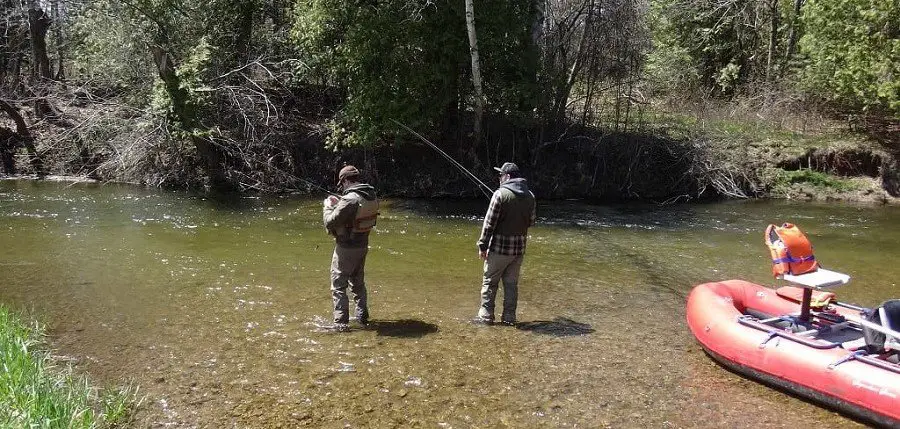
For more information on the right-sized steelhead leaders, go to my Leaders For Steelhead page.
Pros and Cons Of Thick And Thin Lines
- Thick lines are stiff and heavy, which is not good.
- Thick lines sag more. Thick lines will sag and create more of a belly in the line between the rod tip and the float.
- Thick lines will often sink more.
- I’ve found that thick lines don’t cast as well or as far as the thinner lines do.
- I also find that thicker lines don’t come off the reel as nicely as the thinner lines do because they are stiffer.
- I have also noticed thicker lines tend to tangle more often.
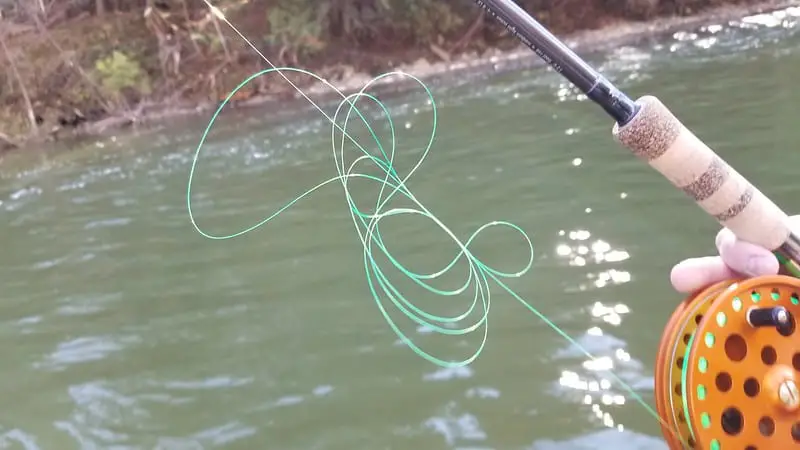
- Thinner lines are much more supple and lightweight and practically fall off the reel when it spins.
- Thinner lines cast easier and farther.
- Thinner and lighter lines will also float higher, which will cause less drag and improve your hooksets.
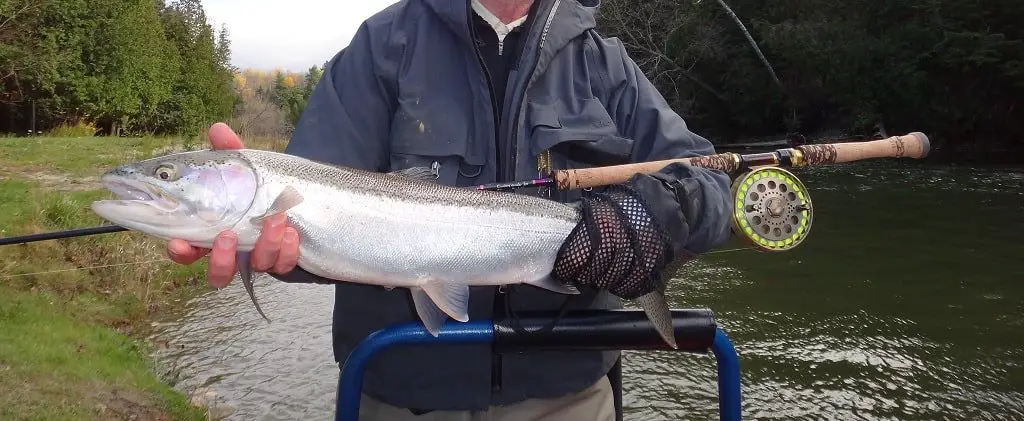
GUIDE TIP: Your line and leader are only as good as your knots. Are you using good knots? Check Out: 4 Best Knots Used By River Guides
Centerpin Lines Ratings Are Flawed
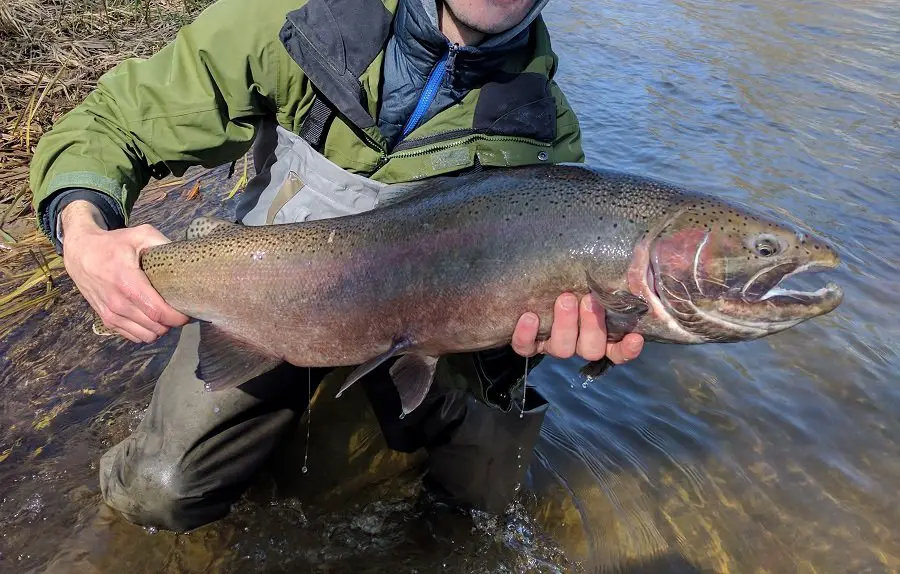
I buy my leaders and mainlines by the diameter size, not the pound rating on the label. I recommend you do the same.
If you look at these popular leaders and compare them to popular Centerpin mainlines, this is what you get:
In my example below, all lines are labeled 8lb or close (7.6 lbs), yet they all have different diameters, and I would bet they will all break at different pound tests. Stronger lines are the thicker lines.
- Redwing Leader 7.6-pound = 0.23mm diameter
- Seaguar STS Leader 8 pound = 0.235
- Berkey XT Mainline 8 pound = is 0.30mm (this could probably lift a 15-pound weight off the floor)
- Raven Mainline 8 pound = 0.26mm
- Sunline Mainline 8 pound = 0.235mm
- Suffix Elite Mainline 8 pound = 0.279mm
You can see most 8-pound leaders are significantly smaller in diameter than most 8-pound mainlines. The reason is that most leaders are rated closer to their true breaking strength.
I mostly use leaders in the 0.20mm and 0.22mm diameter for steelhead on Great Lakes rivers, so my 8-pound Raven mainline that I use is more than enough for steelhead and trout and for salmon in smaller rivers.
What Pound Line On Medium-Sized Rivers?

The best pound test line for Centerpin fishing in small to medium-sized rivers is 8 pounds or 10 pounds for steelhead and 10 to 12 pounds for salmon.
If the river is under 80 feet wide and you have the ability to walk with a fish that is running down the river, then the lighter line is better.
If you can’t chase after a fish for some reason, such as steep banks, or heavily wooded banks, then upsize to a 10-pound or 12-pound test line.
If you want to know all the best Centerpin lines, go to my page 5 Best Float Fishing Lines.
What Pound Line On Large Rivers?
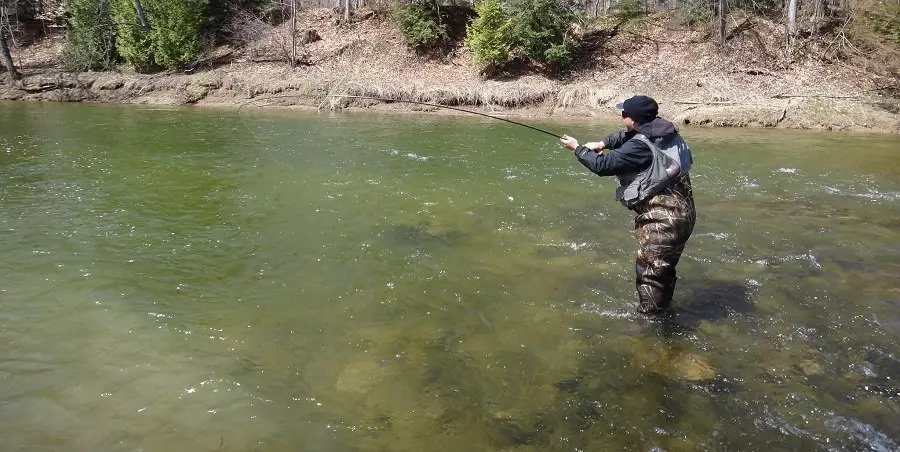
The best pound test line for Centerpin fishing on large rivers where you can’t easily walk up or down the river to chase a fish is 12-pound test.
Most 12-pound lines are closer to 16-pound or 18-pound test. This should be more than enough since your leader will likely be less than that.
Learn To Centerpin Fish Better
Now that you know what pound line you should use for Centerpin fishing, you should consider learning how to use it better. Check out my pages:
- Centerpin Fishing: An Expert Centerpin Guide Explains It
- 2 Float Fishing Leader Setups From A Pro River Guide
Hopefully, I answered all your questions, but if I missed something or you have some advice, let me know in the comments section below.
Tight Lines,
Graham

Hello Graham,
First off, thank you enough for sharing all your fishing knowledge. It is truly greatly appreciated. I live on Vancouver island and I really want to get into Centerpin fishing for Cohos and Chinooks only (no steelhead fishing) at the Somass/Stamp river and Campell river. Thanks to your recommendations, I’m pretty much set regarding the reel and the rod length I want to get. However, I still struggle with the pound line for the mainline/shot line and leader.
On your website, I read a section saying that 10 to 12 lbs is the best for centerpin fishing and I’ve seen else where that 16 to 18lbs is best for Westcoast salmon (which I’m leaning towards to). But I also read in your mainline section that thick line sucks because hard to cast and sagging problems.
Could you please tell me which pound line you recommend for my scenario in terms of mainline/shot line and leader?
Thank you in advance for your help 🙂 I wish you and your family a wonderful holiday season!
Olivier
Hi Oliver,
I know guys that regularly fish Coho and steelhead that will go as light as 10-pound test for the mainline and 8 pounds for their leader. This can work well on slaller rivers where you can walk the banks and chase the fish if needed.
On much larger rivers and in heavy flows, or where wood and log jams may be a problem, or where you can’t chase a fish along the banks, I’d upsize to 12 or even 14 pound mainline with a 10-pound or 12-pound leader.
You are correct, the heavier the mainline, the more sag and problems I have seen, be sure you use a good line..
Even though 12 pound line might sound light, if you strength test most 12-pound lines, they will likely break between 16 and 22 pounds +. and you have a big long rod that acts as a bit of a shock absorber, so the 12-pound line should be strong enough.
Also, the better you get at playing a fish the less likely you will be breaking fish off and the faster you can get them in.
Best of luck.
Graham
THANKS Graham!!!! Much Appreciated!
Olivier
Hi Graham. Thanks for all the great information. I’m learning a lot a looking forward to applying this new knowledge on my up coming trip. This will be my third year trout/steelhead/salmon fishing and so far I’m 0 for 2. I’m hoping for a win on this trip to Manistee and with that, I have a couple of questions.
First You mention small to medium rivers. I would assume the Manistee is a medium size river as it’s not as wild as maybe the Niagara River. Is that assumption, correct? If so, and we are targeting steelhead, a 8 or 10 pound mainline with a 4 to 6 pound leader is a reasonable idea? Do I use a heavier line for the shot line or do I match it to the leader? In one of your diagrams, It looked like your shot line was slightly larger in diameter.
Last bit. I’m still on a spinning reel. I’ve read a lot about center pin and I will most likely switch to that set up in the near future. It’s just a price point for now. I read a lot about braid for main line on spinning reels being a good choice but most of your posts talk about mono for mainline. Would you recommend a braid line for my spinning set up? And if so, what brand would you recommend and what weight or diameter? Thank you again. If tours and teaching is something you still do, I would love to book a trip sometime.
Hey Jason,
I’m glad to hear you are enjoying the website.
To answer your questions:
The Manistee is what I would call a medium-sized river.
For the Manistee and most river of that size and smaller, go with a leader with a diameter of 0.18mm (gin clear) 0.20mm which is good for most water, or 0.22 in dirtier water or when fishing in very fast currents or when you fish near wood or other obstructions and you need to power the fish more. Just remember the thicker the liner the less bites, especially in clear and slower water. Also, Different manufactures have different line rates so 1 brands 6 pound might be more than enough while another brands 6 pound might be too light, so better to go by the diameter.. I run 4 pound Drennan, or 6-pound Seaguar InvizX, both are 0.20mm and same strength..
You are correct, My shot line is always to 2 to 5 pounds heavier and made with fluorocarbon, so basically one or two sizes up from my lower leader. You always want it slightly heavier than your lower leader so the shot line doesn’t break off.
Braid is very good for float fishing and phase a few good benefits. However it also has it’s drawbacks which include wrapping around the tip more often which occurs more often with newer anglers,and it can freeze in the winter if you dunk your reel. You also need to be sure it is put on properly or it can spin around the spool. For these reasons and the fact most of my clienst are newer to fishing, I don’t use braid often on my reels.
These are good lines for braided lines if you want to try them: Sufix 832 Advanced Superline,
Berkley FireLine Thermally Fused Superline,PowerPro Braided Spectra Fiber Line
Getting a good guide is a great idea, but, the Manistee is not my specialty, try Alex from Fireplug Charters.
Best Of Luck,
Graham